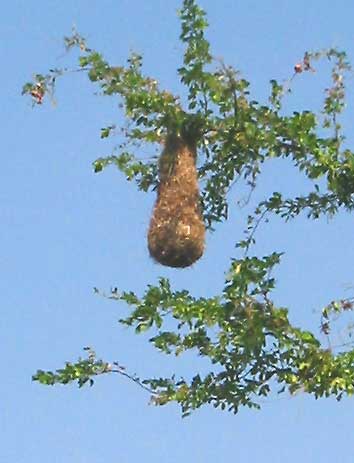Excerpts from Jim Conrad's
Naturalist Newsletter
from the March 24, 2008 Newsletter written in the community of 28 de Junio, in the Central Valley 8 kms west of Pujiltic, Chiapas, MÉXICO
about 800 meters in elevation, ± LAT. 16° 18'N, LONG. -92° 28'W.
YELLOW-WINGED CACIQUES
If the most flamboyant bird here is the White-throated Magpie-Jay, surely the species making the most notable sound is the Yellow-winged Cacique (ka-SEE-keh). Howell describes the voice as "A nasal, crowing, up-slurred RRAHNK and RAAH, a mellow whistled TYOO or TIYIH, a hollow, slightly plaintive WHEEOO?, a clipped CH-TEWK, a ringing CHEHNK, a short, hard, churred rattle, often followed by bell-like notes, KI-ERRR INK-INK-INK... "
The part I like is the bell-like notes. They make me visualize several diaphanously thin sheets of chilled silver tossed onto the ground making a frosty, metallic chiming. There's a haunting, effervescent quality to the notes.
It's easy to visualize a Yellow-winged Cacique. Take a North American Common Grackle, which is just a shade shorter than our cacique, replace the grackle's black iridescence with flat black, paint on brightly yellow wing-patches, rump and tail coverts, provide the bird with a pale bill and a jaunty but often-not-seen crest, and you have a Yellow-winged Cacique. It's a species worth seeing, too, since it's endemic to Mexico's hot, arid, Pacific lowlands, just barely extending onto the Guatemalan coast.
Caciques belong to the same family as grackles and orioles. Up North sometimes you wonder how grackles and orioles could end up to the same family. In fact, if you could hybridize a gaudy oriole with an all-black grackle you'd end up with something like a cacique. This is another instance of when our northern bird groupings sometimes seem to incorporate wildly different species, but when you consider the grouping's more numerous and diverse tropical relatives, relationships become clearer.
From the May MAY 5, 2008 Newsletter written in the community of 28 de Junio and issued from a ciber in Venustiano Carranza, Chiapas, MÉXICO
CACIQUE NEST

Caciques build pendulous nests much like the orioles', to whom they're closely related, but larger and deeper. Above, you can see one about 15 feet up in a Guamuch tree alongside a canal just below the community.
That nest is about 2 feet long (65 cm). Though this is the only cacique nest in the tree (an Altamira Oriole is building a smaller version on the tree's other side), Howell says that sometimes the species nests in colonies, and might even sling its nest on a roadside wire. It produces 2-4 pale blue eggs sparsely flecked with black and gray. Sometimes the species roosts in the hundreds, he says. The species, endemic to Mexico's Pacific Slope lowlands, is common here